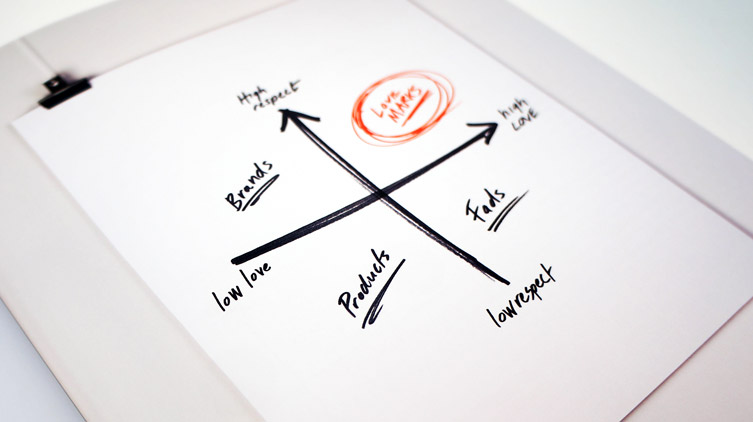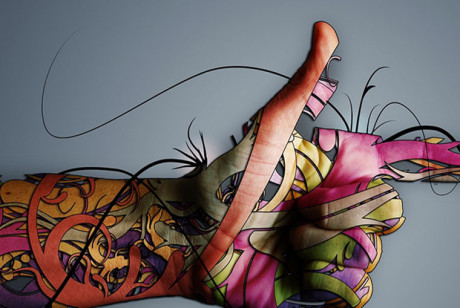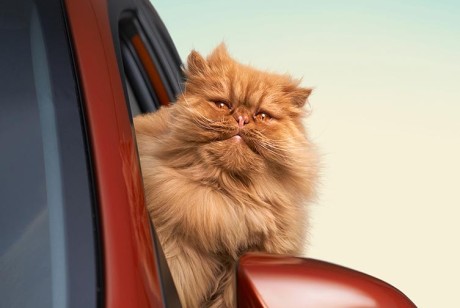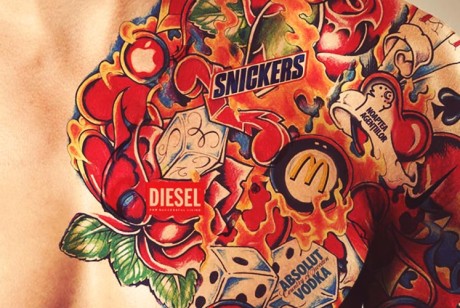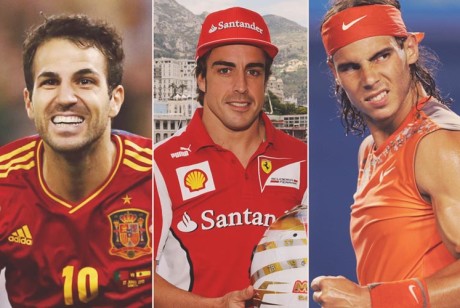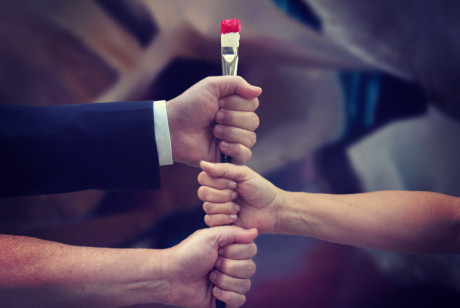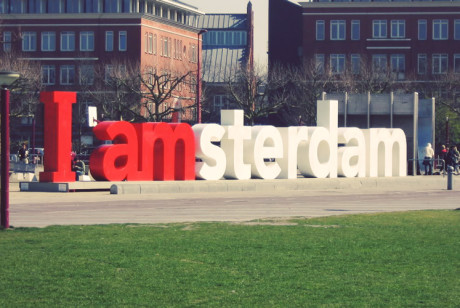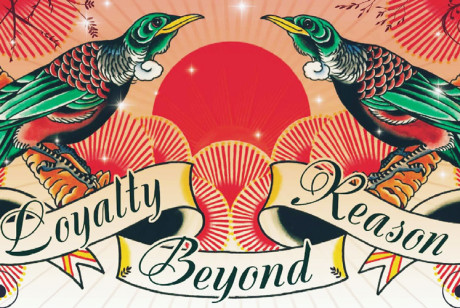On Screen – On Line – In Store
Friday, 18 June 2004 - Barcelona, Spain

Presentation Summary
An Ideas Leadership presentation in Barcelona. The more things change, the more they stay the same. In this mid-year ideas gaze, Kevin Roberts reverse-engineers value-add back from its new-century power source, the consumer. Won in the heart. Touched through sense. Experienced In Store. Found Online. Engaged On Screen. The conclusion? Value remains in ideas, story and interface, not in format and execution. But the possibilities for enterprise to add value to the human condition are now virtually and virally explosive.
I’m going to talk about Return on Involvement.
I’m going to take this idea On Screen, Online and In Store. This begins with the power in enterprise.
Business is the engine of human progress. Its marriage with science delivered the global age. An age of dazzling possibility and, as Madrid has experienced, networked fragility.
Governments can’t manage emotional complexity. Business is borderless and boundless. We inspire change. We realize dreams. We touch and build lives.
The role of business is to make the world a better place for all. The future calls enterprise to action.
Inclusive outcomes involve power. A fashionable view is that retailers are kings. This view is no longer totally accurate.
In the 1980s, manufacturers had the power. The brand controlled pricing, distribution, R&D. In the ’90s power shifted from manufacturers to retailers. Recently there has been a third tipping point. Power passed to the consumer.
Technology settled this. The digital wave accelerated what scientist E O Wilson has called “fluency across boundaries”. Internet evolution – first wired, now wireless – is mainstreaming electronic culture.
By word of click, text and send, every brand is under real time surveillance by billions of eyes. Smart mobs can make or break fortunes overnight. We have witnessed the first wave. The battle of Seattle. Sweatshops in Asia. The SMS ousting of Estrada in the Philippines. Webloggers and e-bay traders. Napster, a jukebox with 70 million human parts.
The second wave is breaking. Peer-to-peer technologies are democratizing economic and political choice – from shopper rap to prison snap.
Passive consumers are becoming increasingly active. They consume. They stream. The quantum advantage is in connecting with Inspirational Consumers, those who actively promote and hold brands accountable to the role of business.
These consumers get closer to brands than earlier adopters, chat leaders, heavy users and their kind. They go beyond choose, use and enthuse. Inspired by deep emotional connections, they sustain their beloved brand through hyper-active engagement.
Prolific word of mouth, feedback at every touch point, stewardship, brand promotion and defense advocacy, insight generation, innovative ideas, dynamic product co-creation… the list can go on.
Seeking out inspirational Consumers and feeding their ideas back into the design, manufacturing, distribution and sales process is plain common sense. Steve Jobs was right. “Creativity is just connecting things.” The Inspirational Consumer is the medium. Passion is the key.
Consumer power is demand-driven. Demand for time. Demand for value.
In the attention economy, time is gold. People are increasingly time-poor and stressed. More information, more offerings, more media, more channels, more time at work – less at play. Disposable time is the new global currency.
The US is a marker. In 1965, 80% of 18 to 49-year-olds could be reached with three 60-second TV spots. In 2002, it took 117 prime-time commercials to match this. Since 1973, US work hours jumped from 41 to 49 a week. Leisure hours fell from 26 to 19. Three quarters of US consumers use different forms of media at the same time.
In the developed world, the broadcast ad. model is heading for nuclear winter. Fixed TV schedules funded by mind-numbing advertisements are now background noise. Time is money. It won’t buy this.
Not with better, cheaper time-management technologies. They sell freedom. Your average viewer wastes three years of life getting bludgeoned by commercials. In the West, on-demand programming and ad-zappers like TiVo and PVRs will revolt this. Digitally-powered consumers will knock out the broadcast model. With an impact that dwarfs the recorded-music and film-photography experience.
For creative agencies, this shift from passive to active consumption is exciting. For some agencies it’s threatening. Why? Advertising has to turn people on not off. If it’s not amazing an experience, it’s pollution. In visual, one question counts: “Do you want to watch it again?” If yes, you’ve connected with an idea. If no, you’ve executed consumers with an ad. Advertising agency revenue will become results-based.
PVRs will kill off 90% of commercials. But the 30 second spot will survive. As long it’s watchable – and memorable.
Demand for value is driven by commodification – that familiar process that erodes distinctions, rapidly cycles through innovations and pushes for higher standards of quality and performance.
Twentieth century marketing evolved from products to trademarks to brands. Now brands are suffering.
In the consumers’ world, snacks are crisp, cars start first time and all beer tastes good. Retail is equally commodified. Price, range and quality are done to death. They won’t drive increasing returns to scale.
To counter the forces of commodification, we abandoned the dogfight to own the consumer. We decided the consumer should own us.
Emotion was the key, an unlimited resource with unlimited power. At the moment of truth people don’t fall back on reason. They respond to emotion.
Brain scientist Donald Calne sums up: “The essential difference between emotion and reason is that emotion leads to action, while reason leads to conclusions.” More emotion, more action.
In a space beyond brands, we created Lovemarks.
Start with Low Respect and Low Love. Standard commodities. Public Utilities. Rubbish collection, and cement. Essential but static. Zero brand heat.
Move to Low Respect and High Love. Fads, trends, infatuations. This month’s gotta-haves. Next month’s has-beens. Everything from Ugg boots to Troy.
High Respect and Low Love. This is where most major brands are stuck. Great products, solid sales, effective distribution. All fixed on the “e-r” words. Brighter, stronger, bolder… cheaper. All table-stakes.
High Respect / High Love. Lovemarks. New value. Superb quality, deep emotion, empathy.
- Lovemarks are built on Love and Respect.
- Lovemarks inspire loyalty beyond reason.
- Lovemarks connect companies, their people and their brands.
- Lovemarks are owned by the people who love them, not by companies.
- Lovemarks can be anything people care deeply about.
Lovemarks are the charismatic brands that people can’t live without. You know them instantly whether you are in New York, Shanghai, Beirut or Barcelona.
- McDonalds is a Lovemark. Burger King has got the taste but not the Love.
- Harley Davidson, definitely. Suzuki? I don’t think so.
- Oprah? Believe it. Martha Stewart? Got close but you have to hold onto Respect.
Lovemarks are not just irreplaceable. They are Irresistible.
- A Master’s Green Jacket is Irreplaceable, but the grace of Tiger Woods is Irresistible.
- Walt Disney proved Irreplaceable, but his creation Mickey Mouse is still Irresistible.
- The Met Museum of Art is Irreplaceable. Frank Gehry’s Bilbao Guggenheim is Irresistible.
The three essential qualities of a Lovemark are Mystery, Sensuality and Intimacy.
Mystery to draw together stories, metaphors, dreams and symbols. Most brands squeeze out Mystery with too much information. People are drawn to what they don’t know. When we know everything, there’s nothing left to learn.
Second Sensuality Sight, hearing, smell, touch, taste. Our senses alert us, lift us, transport us. Through the five senses we experience the world.
Third Intimacy. The fine art of being close to consumers, without getting in their faces. Empathy, commitment and passion. The intimate connections that win undying loyalty. Intimacy is about having your ear close to the heart.
Lovemarks unsaturate brands and retail. They replace return on investment with return on involvement. Three connected spaces offer supreme advantage in the media mash. On Screen. On line. In Store.
First a principle: Models die / Media don’t. Society replaces stuff when it creates better not newer stuff. Books on paper and art on canvas are eternal. People give meaning to technology not the reverse.
TV is here to stay. In the developed world everyone has one, knows how to use one, and it’s the best medium invented for emotional, multi-dimensional story-telling. For infotainment, no media competes. Americans watch four hours a day. Euros three and a half, with housewives maxing time among viewers.
In the developing core – China, India, Brazil, Russia – TV will dominate for the next decade. In three-hours-a day-China, TV reaches over 80% of the population, with newspapers a distant second at 65%.
Virtual TV is years away in these countries. Pay no attention to anyone who tells you different.
TV will dominate not exclude. All media survive. This is The Age of Also. Value is in ideas and interface, not format and execution. Cyber-scientist David Gelernter is right: “We spend around 80 percent of our energy worrying about form, and 20% on content. Fifty years from now, this will be reversed.”
The relevance in media is their meeting point, the screen – that fascinating, pulsing, lit-up, connecting window on the world. The screen is everywhere. It is a meeting and market place for six billion consumers. More and more, our lives cycle through windows. From Mobile and Movie to TV and Computer, the screen is the 21st century’s global commons.
The power in the screen is SISOMO. A connection made through sight, sound and motion. It has emotional, multi-dimensional story-telling power. It can take sight, sound and motion to new heights of entertainment, sensuality and intimate interactivity.
Online proliferation and use explodes SISOMO’s potential beyond TV. Internet usage and ease is hyper-accelerating. From e-mail and immersive gaming to personal shopping and B2B marketing, real is virtual and virtual is increasingly real. Business, leisure and life are being seamlessly webbed.
Gender is huge in the digital blender. Time-crunched women are flocking on line. Forget chat rooms. Women are in every room. News and information is first choice – astrology last, after sports! A recent US Yahoo survey found 82% of women go on-line first for researching a topic.
Over 10% of women said they had used the Internet to generate income. 43% are regularly purchasing items over the Internet. On a desert island with one choice of media, 65% chose the Internet, 22% TV, 7% radio, and 3% magazines.
On-line is an enhancement not a replacement. It’s And / And not Either / Or.
Three out of four Americans start shopping for new cars online but most still buy from traditional dealers. A recent 3-month survey found that half of Europe’s 60 million on-line consumers bought products offline after an online investigation.
The more things change the more they stay the same. Everything must start with the brand equity. Second create an inspired idea. Individualize it. Drip it with mystery, sensuality and intimacy. Digitize it with sight, sound and motion. Push it two-way. Infect and involve Inspirational Consumers from Bombay to Barcelona. Viral velocity will do the rest.
For 2000 years enterprise has been sold through emotional stories. It will be for the next 10, 000. Technology enables and enhances. Ideas transform. The challenge is to tell stories that move the world.
On Screen can put a brand on the shopping list. It still has to go in the basket. The breaking opportunity occurs in an emotional vacuum inside a financial wasteland.
Eghty percent of purchase decisions and 50% of brand switching occur in the Store. Shoppers ignore 50% of displays. Most manufacturers and retailers ignore this. They are giving away billions of dollars.
Supermarkets are a nightmare experience. Why does in-store radio have to be so painfully bland? Who looks good under that supermarket lighting? What should be a theater of dreams is a warehouse of dread.
Housewives deserve better than a 20-minute dash through hell. They’ll come looking for better. The most powerful medium on the planet is an insult to consumer primacy. In-store creative is a joke. Coupons, rebates, games, drawings, price points, end displays with mark downs. Retail promotion today is a one night stand. Last year PepsiCo gave away $1 billion … with a chimpanzee picking the winner! Instead of forever loyal customers, you get promiscuity.
The store presents the greatest creative revolution since TV. Wal-Mart has 138 million shoppers a week. They have one question. How do I make the 20 minutes shoppers spend in Wal-Mart 21 minutes?
The answer is mystery, sensuality and intimacy. Transform a landfill for corrugated displays into a theatre of dreams. That’s how to turn shoppers into buyers.
Shopper marketing completes the creative idea behind the brand through the shopping experience. This reverse-engineers the entire product, packaging and retail experience from the viewpoint of the shopper. It combines pattern recognition, interactive design, floor architecture, cultural insight, and package innovation.
Above all, creative genius. Shopper marketing choreographs shoppers, brands and space into a world of surprise, metaphor, inspiration and dream.
- A fruit stall as a country market.
- A clothes floor as a fashion runway.
- A check-out queue as a short story.
- A cart with I-Pod as shopping trolley.
- A pet food aisle as a jungle safari.
- An ocean aquarium selling seafood.
- A snacks corridor as the spice route.
On screen, On line, In store, In use, it is not enough to tell. Like all good stories you have to show. And the greatest show on earth – is love, no matter how old you are.
Putting love in business rises beyond sales. Wherever love goes, it makes a difference. With love as a charter for business, a better world is possible.
Fundamentally it is lack of self-esteem, lack of choice and lack of time that breaks society down. Business has unique capacity to invest in and change this.
The Screen and the Store are global. Progress is not. It lies in the local where people dream, live, laugh and cry. It lies in investing in and uplifting 4 billion poor people, the largest untapped consumer market on earth. New R&D, new ideas, new distribution can unlock purchasing power and deliver on dreams.
This is a consumer not retailer world. Profit has four dimensions: Economic, Social, Ecological, Ethical. To be sustainable, an enterprise has to create a Winning Zone, love its Planet Home, inspire a Family of One, and provide Safe Hands. Nothing less will do.
Return on investment is table stakes. It’s return on involvement that counts.
